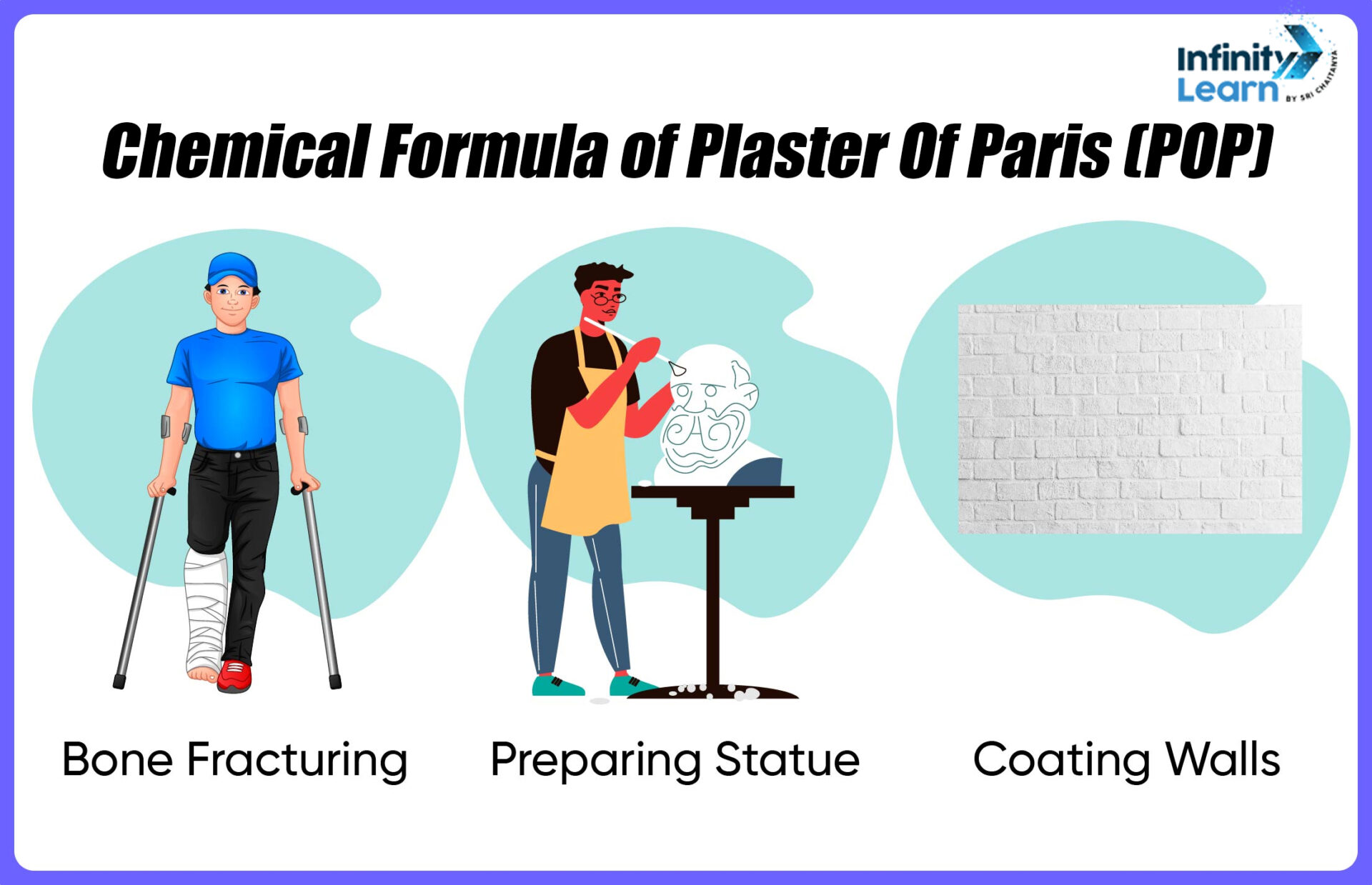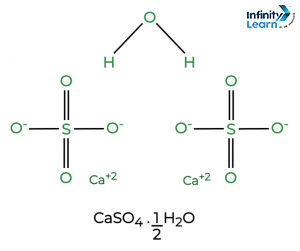Table of Contents
POP Chemical Formula: Plaster of Paris, a renowned chemical compound, finds extensive usage in both sculpting materials and medical applications such as gauze bandages. Although we encounter numerous uses of Plaster of Paris in our everyday experiences, it’s essential to understand its composition. In this article, we’ll explore the Plaster of Paris (POP) chemical formula, its myriad uses, structure, types, and properties, along with their respective advantages and disadvantages.

What is POP (Plaster Of Paris)
Plaster of Paris (POP) is a versatile building material commonly used in construction, art, and medical applications. Through a process of heating and grinding, gypsum, a naturally occurring mineral, transforms into Plaster of Paris (POP). When water is added to POP, it forms a workable paste that craftsmen can mold into various shapes. Subsequently, the paste hardens into a durable solid, making it suitable for a wide range of applications in construction, art, and medicine. Its quick setting time and ability to retain fine details make it popular for creating sculptures, molds, and decorative elements in architecture. It serves as a fundamental material in numerous creative, architectural, and medical endeavors.
Also Read: Important Questions on Acid, Bases and Salts
Chemical Formula of POP (Plaster Of Paris)

The chemical compound known as Plaster of Paris is Calcium Sulphate Hemihydrate, represented by the formula CaSO4.1/2H2O. It comprises calcium, sulfur, oxygen, and water molecules. In its structure, a calcium atom bonds with a combination of a sulfur atom and four oxygen atoms, forming sulfate. Subsequently, this compound bonds with two water molecules, leading to the formation of Calcium Sulphate Dihydrate. Thus, the molecular composition of Plaster of Paris involves these interconnected elements. Therefore, the molecular structure of Plaster of Paris consists of these interconnected elements.
Molecular Formula of POP (Plaster Of Paris)
Plaster of Paris, also known as calcium sulfate hemihydrate, possesses both the same chemical and molecular formula, represented as CaSO4·1/2H2O. POP chemical formula signifies that each molecule of Plaster of Paris consists of one calcium sulfate molecule bonded with half a molecule of water.
Properties of POP Chemical Formula
- Hydration Property: Plaster of Paris (POP) contains water molecules, as indicated by its chemical formula CaSO4·1/2H2O. This characteristic allows it to form a paste when mixed with water.
- Quick Solidification: Upon mixing with water, POP undergoes rapid solidification, making it suitable for applications requiring swift results, such as casting and mold-making.
- Strength and Endurance: Once set, POP becomes robust and long-lasting, making it suitable for various purposes, including construction, sculpting, and medical casts.
- Moldability Feature: POP’s malleable paste enables effortless shaping into diverse forms and intricate designs before it hardens, facilitating artistic and architectural endeavors.
- Versatility Trait: With its distinct chemical composition, POP finds utility across a wide array of industries, including construction, art, and medicine, showcasing its adaptability and practicality.
Uses of Plaster Of Paris
- Construction: POP is used to craft decorative elements like cornices and ceiling tiles.
- Art and Sculpture: Artists sculpt with POP due to its moldability and detail retention.
- Medical Casting: POP creates lightweight, sturdy casts for injured limbs.
- Dental Models: Dentists use POP for accurate dental models and prosthetics.
- Architectural Restoration: POP replicates intricate details in historic buildings.
- DIY Crafts: Hobbyists craft various items like candle holders with POP.
- Prototype Making: POP creates detailed prototypes and molds for products.
- Education: POP facilitates hands-on learning in science, art, and architecture.
Advantages and Disadvantages of Using Plaster Of Paris
| Advantages | Disadvantages |
| 1. Easy to use and mold | 1. Limited durability |
| 2. Quick setting time | 2. Susceptible to moisture damage |
| 3. Versatile in various applications | 3. Can crack or chip easily |
| 4. Affordable material | 4. Limited load-bearing capacity |
| 5. Suitable for detailed casting and molding | 5. Requires careful handling during mixing |
| 6. Lightweight and easy to transport | 6. Causes skin irritation if not handled properly |
| 7. Can be painted or finished for aesthetics | 7. Limited temperature resistance |
| 8. Widely available in stores | 8. Not suitable for outdoor applications |
FAQ’s on POP Chemical Formula
What is the chemical formula for (Plaster of Paris) POP?
The chemical formula for Plaster of Paris (POP) is CaSO4·1/2H2O, indicating its composition of calcium sulfate hemihydrate.
What is the chemical name of plaster of Paris?
The chemical name of plaster of Paris is calcium sulfate hemihydrate.
What is the formula of POP CaSO4?
The formula for Plaster of Paris, CaSO4·1/2H2O, signifies its composition, which involves calcium sulfate combined with water in a specific ratio.
What is the chemical formula for the formation of POP (Plaster of Paris)?
Plaster of Paris is formed when gypsum, with the chemical formula CaSO4·2H2O, is heated, driving off some water molecules, resulting in calcium sulfate hemihydrate.
What is the chemical formula of gypsum?
Gypsum, the precursor to Plaster of Paris, has the chemical formula CaSO4·2H2O, signifying its composition of calcium sulfate dihydrate.
Why is CaSO4 h2o called plaster of Paris?
Plaster of Paris got its name because it was commonly used in Paris for building and sculpting back in the 17th century.









